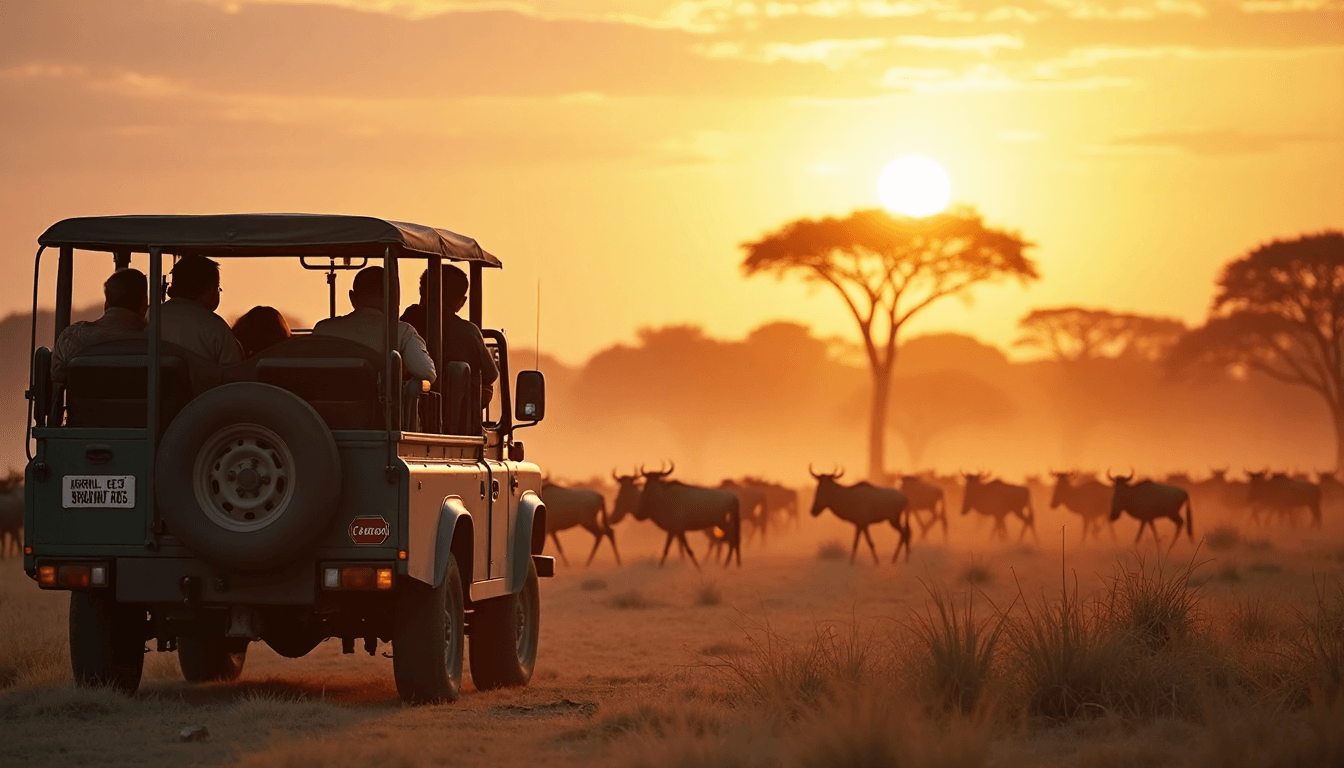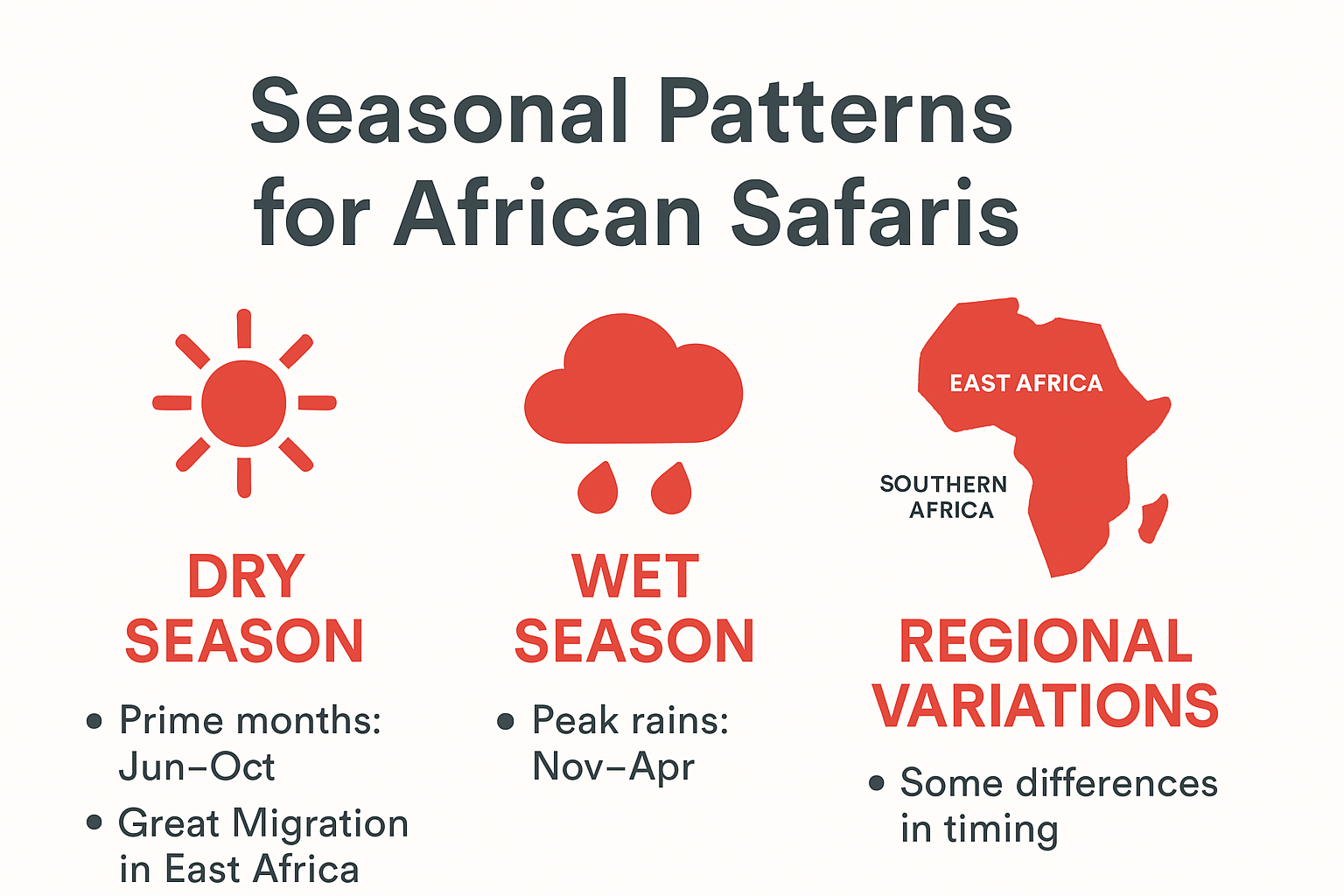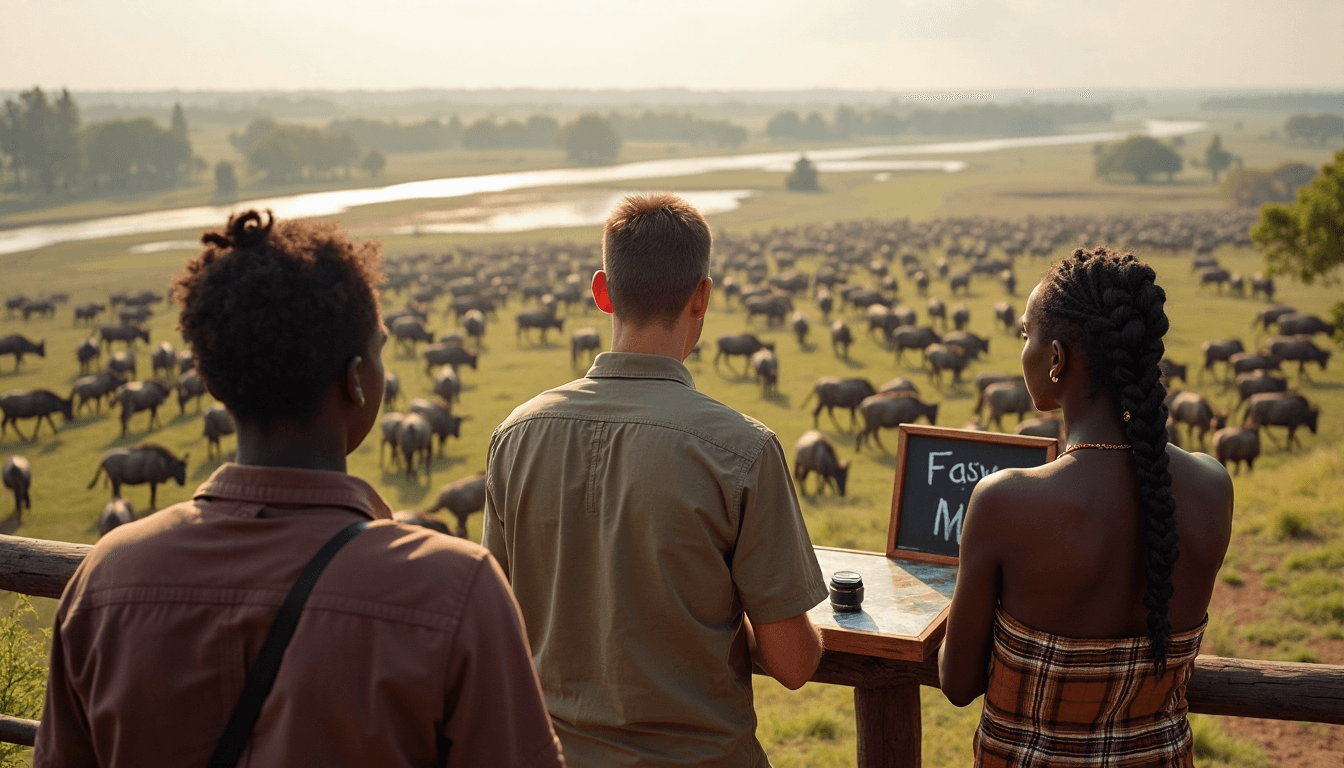Best Time for African Safari 2025: When To Go For Wildlife
Full Disclosure: Our AI Assistant Writes These!
While we're out in the bush tracking leopards, dodging elephants, and trying to get the perfect sunset shot, our trusty AI companion is back at camp, diligently crafting these blog posts. Don't worry though - it's been trained on years of real safari experiences and only occasionally suggests that tourists should pet the lions. (Please don't pet the lions. The AI was joking. We hope.)
The real reason? SEO loves fresh content, and we love fresh adventures. So while our AI handles the keywords and search rankings, we're out there finding the next hidden waterhole, secret viewpoint, or that one tree where the leopards always hang out. Win-win, really!
Best Time for African Safari 2025: When To Go For Wildlife

Everyone wants to see the drama of the wild on an African safari. You might think the action picks up when the animals do but here’s something surprising. The best wildlife sightings often happen in the dry season, when up to 1.5 million wildebeest cross the Maasai Mara between July and September. Forget the lush, rainy backdrops you see in travel magazines. The true magic lies in timing your trip with these epic seasonal changes, not just the scenery.
Table of Contents
- Understanding African Safari Seasons
- Top Destinations And Peak Safari Months
- Best Times For Different Safari Experiences
- Tips For Planning Your Safari In 2025
Quick Summary
| Takeaway | Explanation |
|---|---|
| Understand Seasonal Variations | Planning an African safari requires knowledge of seasonal patterns, as wildlife movements and viewing opportunities vary across regions and months. The dry season from May to October is particularly advantageous for game viewing across Southern Africa, while the Great Migration peaks between July and September in East Africa. |
| Research Top Destinations | Iconic destinations like Maasai Mara and Serengeti are prime for witnessing significant wildlife events. Understanding peak viewing periods for specific areas ensures travelers don’t miss the unique experiences these locations offer, such as the calving season in Southern Serengeti from January to March. |
| Health and Safety Preparations | Prioritize health by consulting a travel health specialist 4-6 weeks before departure for vaccinations and travel insurance. This is essential for ensuring safety in remote safari areas with limited medical access. |
| Budget and Booking Strategies | Book safari trips well in advance to secure better prices and availability, with potential savings of 15-25%. Consider flexible travel dates and shoulder seasons for budget-friendly options without compromising wildlife viewing. |
| Practical Travel Considerations | Prepare for varying climates by selecting appropriate clothing, ensuring technology preparedness, and understanding visa requirements for different African countries, all crucial for a smooth safari experience. |
Understanding African Safari Seasons
Planning an African safari requires understanding the intricate seasonal variations that dramatically influence wildlife movements and viewing opportunities. Each region across the continent presents unique ecological patterns that determine the optimal wildlife viewing periods.

The Rhythm of African Ecosystems
African safari seasons are fundamentally driven by rainfall patterns, which create complex ecological cycles affecting animal behavior and landscape transformations. According to National Geographic, these seasonal shifts are not uniform across the continent but follow distinct regional rhythms.
In East Africa, two primary rainy seasons define the ecological calendar. The ‘long rains’ occur from March to May, transforming landscapes into lush green environments. Conversely, the ‘short rains’ happen in October and November, creating temporary water sources that attract diverse wildlife. These rainfall patterns significantly impact animal migrations, particularly the legendary wildebeest migration in the Serengeti.
Dry Season Dynamics
The dry season, typically spanning from May to October in Southern Africa, represents a critical period for wildlife observation. During these months, reduced vegetation and limited water sources concentrate animals around remaining waterholes, creating exceptional game viewing opportunities. Wildlife conservation researchers note that this concentration makes tracking and observing animals considerably easier for safari enthusiasts.
Dry season landscapes transform dramatically. Sparse vegetation and receding water sources force animals into predictable movement patterns. Predators strategically position themselves near remaining water sources, creating high-tension ecological interactions that offer photographers and wildlife enthusiasts extraordinary viewing experiences.
Regional Variations and Ecological Complexity
While general seasonal patterns exist, Africa’s diverse ecosystems demand nuanced understanding. Southern African regions like Kruger National Park experience different seasonal dynamics compared to East African locations such as the Maasai Mara. Temperature variations, rainfall patterns, and specific geographical features create unique wildlife viewing windows.
These regional differences mean that optimal safari timing varies significantly. Understanding these ecological rhythms becomes crucial for travelers seeking memorable wildlife encounters. Temperature, humidity, animal migrations, and landscape conditions all interplay to create windows of exceptional safari experiences.
For travelers planning their 2025 safari adventures, studying these seasonal variations becomes paramount. Each month offers distinct perspectives into Africa’s extraordinary wildlife ecosystems, presenting opportunities for unforgettable encounters with nature’s most magnificent creatures.
Top Destinations and Peak Safari Months
Africa boasts numerous extraordinary safari destinations, each offering unique wildlife experiences and distinct peak viewing periods. Understanding these iconic locations and their optimal months helps travelers plan unforgettable wildlife adventures in 2025.
East African Safari Highlights
East Africa represents the pinnacle of wildlife migration experiences. The Maasai Mara in Kenya stands out as a premier destination, particularly during the Great Migration. According to National Geographic, the epic wildebeest migration typically peaks between July and September. During these months, approximately 1.5 million wildebeest traverse treacherous river crossings, creating dramatic scenes of survival and natural spectacle.

The Serengeti in Tanzania offers complementary migration experiences. Research from African Wildlife Foundation indicates that the southern Serengeti becomes particularly compelling from January to March, coinciding with the wildebeest calving season. Thousands of newborn calves attract predators, generating intense wildlife interactions that photographers and nature enthusiasts cherish.
Southern African Wildlife Hotspots
Southern Africa presents distinct safari experiences with incredible diversity. Kruger National Park in south africa stands as a premier destination, offering exceptional wildlife viewing during the dry winter months from May to September. Wildlife researchers confirm that reduced vegetation during this period dramatically improves animal visibility, making it an ideal time for game viewing.
The Okavango Delta in Botswana represents another extraordinary destination. According to UNESCO World Heritage, this unique ecosystem experiences its annual flood between June and August. These months transform the landscape, creating temporary waterways that attract diverse wildlife concentrations. Elephants, hippos, crocodiles, and numerous antelope species become exceptionally visible during this remarkable seasonal transition.
Unique Regional Experiences
Beyond mainstream destinations, Africa offers remarkable niche safari experiences. Namibia’s Etosha National Park provides exceptional wildlife viewing from June to October, when animals congregate around limited water sources. The sparse vegetation and strategic waterholes create unparalleled observation opportunities.
In South Africa’s lesser-known reserves like Madikwe and Pilanesberg, winter months offer extraordinary game viewing experiences. These malaria-free zones become particularly attractive for families and travelers seeking diverse wildlife encounters without health risks.
Travelers planning 2025 safaris should recognize that peak months vary significantly across regions. While July to September offers spectacular experiences in East Africa, Southern African destinations shine brightest from May to September. Careful planning and understanding these nuanced seasonal variations ensures travelers maximize their wildlife encounter potential across this magnificent continent.
To help you compare the top safari destinations and their peak months, here is a summary table:
| Destination | Country | Peak Months | Unique Sightings/Events |
|---|---|---|---|
| Maasai Mara | Kenya | July – September | Great Migration, dramatic river crossings |
| Serengeti (Southern) | Tanzania | January – March | Calving season, predator activity |
| Kruger National Park | South Africa | May – September | Dense wildlife, high visibility |
| Okavango Delta | Botswana | June – August | Flood season, concentration at waterways |
| Etosha National Park | Namibia | June – October | Wildlife at waterholes, sparse vegetation |
| Madikwe & Pilanesberg Reserves | South Africa | May – September | Malaria-free, great family-friendly viewing |
Best Times for Different Safari Experiences
African safaris offer a kaleidoscope of experiences, each demanding unique timing and strategic planning. Different wildlife encounters require specific seasonal windows, transforming travel strategies for wildlife enthusiasts and photographers alike.
Wildlife Migration and Dramatic Encounters
The Great Migration represents the pinnacle of wildlife spectacle. According to National Geographic, the most dramatic river crossings occur between July and September when approximately 1.5 million wildebeest navigate treacherous Mara River currents. Our specialized safari guide recommends positioning yourself in the Masai Mara during these months to witness these extraordinary moments.
Beyond river crossings, the migration offers nuanced experiences. From January to March, the southern Serengeti transforms into a massive nursery during the calving season. Wildlife researchers note this period attracts predators like lions and cheetahs, creating intense ecological dramas as thousands of wildebeest calves navigate their first weeks of life.
Specialized Wildlife Photography Seasons
Photographers seeking specific wildlife encounters must strategically time their safaris. The dry season from May to October provides exceptional visibility. Professional wildlife photographers highlight that reduced vegetation and concentrated water sources create ideal conditions for capturing animal behaviors.
In regions like Kruger National Park, winter months offer unparalleled photographic opportunities. Sparse bushveld and predictable animal movements around waterholes enable photographers to capture intimate wildlife moments. Predators become more visible, and long-lens enthusiasts can document intricate social dynamics among lion prides and elephant herds.
Unique Seasonal Wildlife Experiences
Beyond traditional game viewing, Africa offers extraordinary niche experiences tied to specific seasonal windows. The Okavango Delta in Botswana presents a remarkable example. According to UNESCO World Heritage, the annual flood between June and August transforms the landscape, creating temporary waterways that attract diverse wildlife concentrations.
Birdwatchers find the wet season particularly compelling. From November to April, migratory bird species arrive, turning landscapes into vibrant avian theaters. Ornithological research indicates this period sees remarkable species diversity, with numerous migratory birds complementing resident populations.
Travelers planning 2025 safaris must recognize that each ecological region presents unique rhythms. While East African destinations peak from July to October, Southern African experiences shine brightest from May to September. Understanding these nuanced seasonal variations ensures travelers craft personalized wildlife encounters aligned with their specific interests.
The magic of an African safari lies not just in witnessing wildlife but in understanding the intricate seasonal choreography that drives these extraordinary ecosystems. By selecting the right time and location, travelers transform a simple trip into an profound journey of natural discovery.
Here is a table highlighting the best periods for diverse safari experiences by type and region:
| Safari Experience | Region | Best Time | Key Highlights |
|---|---|---|---|
| Great Wildebeest Migration | East Africa (Kenya/Tanzania) | July – September | River crossings, predators |
| Calving Season | Southern Serengeti | January – March | Newborn wildlife, predator activity |
| Game Viewing (Dry Season) | Southern Africa | May – September | Easy viewing at waterholes |
| Okavango Delta Flood Experience | Botswana | June – August | Water-based sightings, birdlife |
| Birdwatching (Migratory Birds) | Various | November – April | Migrant species diversity |
| Malaria-Free Family Safaris | Madikwe/Pilanesberg | May – September | Safe for families, varied wildlife |
Tips for Planning Your Safari in 2025
Successful safari planning requires strategic preparation, understanding intricate travel considerations, and aligning expectations with Africa’s dynamic wildlife landscapes. Travelers embarking on 2025 safari adventures must navigate complex logistical and environmental factors to ensure memorable experiences.
Health and Safety Preparation
Prioritizing personal health becomes paramount when planning an African safari. Centers for Disease Control recommends comprehensive medical preparations, including vaccination requirements and antimalarial precautions. Travelers should schedule consultations with travel health specialists at least 4-6 weeks before departure, ensuring complete immunization protocols.
Vaccination recommendations typically include hepatitis A and B, typhoid, yellow fever, and updated routine immunizations. World Health Organization emphasizes the importance of comprehensive travel insurance covering medical evacuation, a critical consideration in remote safari destinations where immediate medical access might be limited.
Budgeting and Booking Strategies
Financial planning represents a crucial aspect of safari preparation. Our comprehensive safari guide suggests booking well in advance to secure optimal pricing and availability. Research from travel economic analysts indicates that early bookings can result in savings of 15-25% compared to last-minute arrangements.
Consider diverse accommodation options ranging from luxury lodges to mobile camping experiences. Budget-conscious travelers should explore shoulder season opportunities, typically occurring between peak and off-peak periods. These windows offer more affordable rates while maintaining excellent wildlife viewing potential. Experts recommend flexibility with travel dates to maximize cost-effectiveness.
Practical Travel Considerations
Effective safari planning extends beyond financial and health preparations. Wildlife conservation experts recommend understanding specific regional requirements. This includes selecting appropriate clothing for variable temperatures, packing lightweight, neutral-colored attire, and bringing essential photography and observation equipment.
Technology preparation becomes increasingly important. Travelers should ensure international mobile coverage, portable charging solutions, and backup communication devices. Many remote safari locations have limited connectivity, making advanced technological planning essential. Additionally, research local electrical standards and bring appropriate adapters to maintain communication and camera equipment.
Understanding visa requirements represents another critical planning component. Different African countries maintain distinct entry regulations. International travel authorities recommend initiating visa applications at least three months before departure, allowing sufficient processing time and preventing potential travel disruptions.
For 2025 safari experiences, travelers must embrace flexibility and comprehensive preparation. The most successful adventures result from meticulous planning combined with an openness to unexpected wildlife encounters. By approaching safari planning as a holistic process addressing health, financial, and practical considerations, travelers can transform their African wildlife journey into an extraordinary, once-in-a-lifetime experience.
Frequently Asked Questions
When is the best time to go on an African safari?
The best time to go on an African safari is during the dry season, from May to October, particularly in Southern Africa. In East Africa, the peak season is from July to September when the Great Migration occurs.
Why is the dry season better for wildlife viewing?
The dry season is better for wildlife viewing because animals congregate around limited water sources, making them easier to spot. Reduced vegetation also enhances visibility, offering excellent opportunities for photography and observation.
What are the top destinations for a safari in Africa?
Top destinations for an African safari include the Maasai Mara in Kenya, the Serengeti in Tanzania, Kruger National Park in South Africa, and the Okavango Delta in Botswana. Each location has its peak months for optimal wildlife experiences.
What should I consider when planning a safari in 2025?
When planning a safari in 2025, consider health and safety preparations, budget and booking strategies to secure the best prices, and practical travel considerations such as visa requirements and appropriate clothing for varying climates.
Ready for the Ultimate African Safari at the Perfect Time?
You have just learned why catching the right season for your safari can make the difference between ordinary animal sightings and jaw-dropping wildlife action. Planning a 2025 adventure means more than picking a date. You want to witness the Great Migration, those thrilling river crossings, and vibrant calving events, but getting the timing right can be overwhelming. Many travelers miss out on these moments because they struggle to match their travel dates to the best wildlife seasons across different regions. Africa Awesome is here to change that.

Let our team at Africa Awesome remove the uncertainty. We combine expert guidance, flexible payment options, and the know-how to craft tailored itineraries for every dream and budget. Speak to our specialists, browse real reviews from past guests, and explore safe, secure booking for destinations like Kruger National Park, the Maasai Mara, and the Serengeti migration. This could be the year you experience a truly unforgettable African safari. Visit our main website today or start planning your own impactful journey by reaching out to our friendly team for a personalized quote. Secure your spot now before the best safari months fill up.